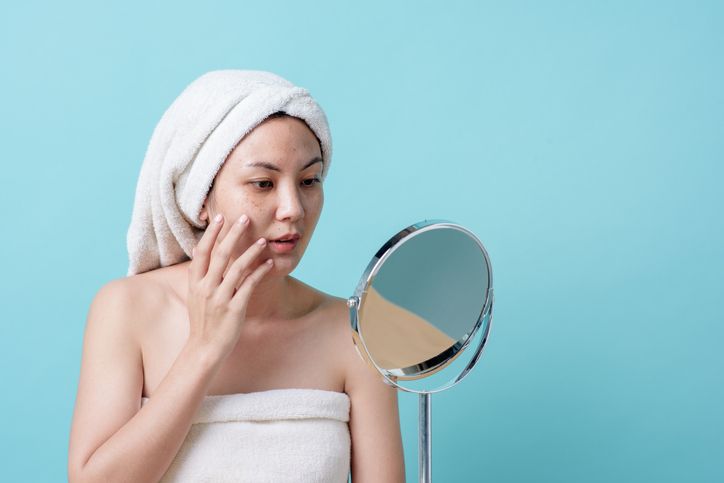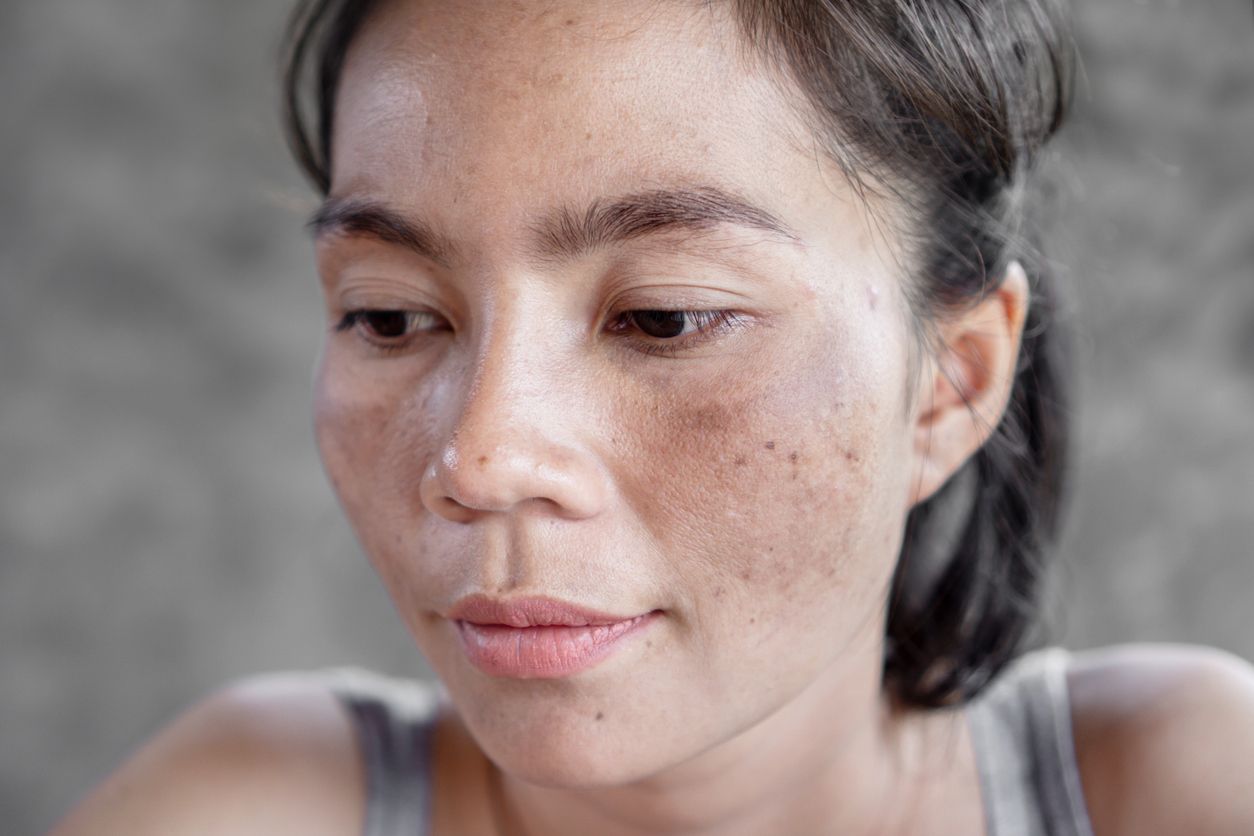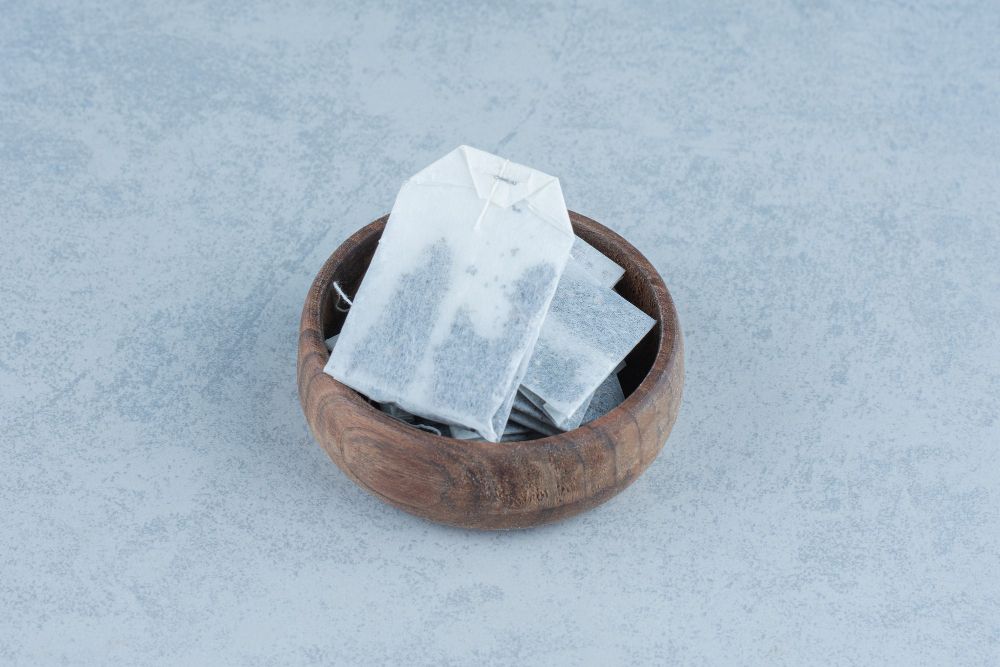Author: Natalie Ng|Updated: 23 April 2025
Hormonal pimples on the chin are a common issue, especially for people dealing with hormonal fluctuations. These breakouts often show up as deep, painful pimples and are harder to treat than regular acne. They tend to form when changes in hormone levels increase oil production, which clogs pores with dead skin cells and acne-causing bacteria. This kind of acne usually appears around the lower face and jawline, and it can affect both teens and adults—especially those with irregular periods, polycystic ovary syndrome (PCOS), or stress-related hormone changes. It’s also more likely to flare up during certain points in the menstrual cycle. If you’ve been stuck with recurring chin breakouts, you’re not alone. Keep reading to learn about six proven ways to treat hormonal acne and get to the root of the problem.

How to Prevent Dark Spots: Understanding Their Root Causes

1. Sun Exposure Triggers Melanin Production
Too much sun is one of the main reasons people develop dark spots. These dark patches are often called sunspots and typically appear on areas that receive the most sun exposure, such as the face, hands, and arms. UV rays hit the top layer of the skin and trigger melanin production. This is your skin’s way of trying to protect itself, but it often leads to uneven skin tone and darker patches—especially on areas that get the most sun exposure, like the cheeks, upper lip, and forehead.
Wearing broad spectrum sunscreen daily helps prevent dark spots from forming and stops existing ones from getting worse.
2. Hormonal Changes Can Lead to Melasma
Hormonal shifts, especially during pregnancy or from taking birth control pills, can lead to melasma. This condition causes patchy dark spots, usually on the face, affecting the overall complexion. It’s more common in people with darker skin tones and can be harder to treat without making the skin more sensitive.
3, Inflammation Causes Post Inflammatory Hyperpigmentation
When the skin is irritated or inflamed—like after acne, an insect bite, or a rash—it can leave behind dark marks. This is called post-inflammatory hyperpigmentation and can affect people of all skin tones, often taking time to fade. It’s common in people with both lighter and darker skin tones, and the spots often take time to fade.
4. Skin Trauma and Picking Worsen Pigmentation
Picking at acne, scratching at bites, or even using harsh exfoliants can damage the skin and lead to dark spots. These habits slow down healing and make it harder for the skin to return to an even tone.

The Critical Role of Sun Protection
Why Sun Exposure Causes Dark Spots
Sun exposure is one of the most common reasons people develop dark spots, especially if they skip daily sun protection. UV rays trigger melanin production, and over time, this leads to brown spots, age spots, and uneven skin tone. It doesn’t matter if the sun is out or if it’s cloudy—those rays still reach your skin.
While dark spots are often not a medical concern, many people seek to prevent them for cosmetic reasons, aiming to maintain a clear and even complexion.
UVA rays also pass through glass. That means your skin is still exposed while driving, sitting near a window at work, or relaxing at home. If you’re not protecting your skin daily, these rays can worsen existing dark spots and increase the chance of developing new ones.
SPF Every Day, Not Just on Sunny Days
Applying broad-spectrum sunscreen every morning helps prevent dark spots and stops hyperpigmentation from getting worse. Choose one with at least SPF 30. Reapply it every two hours if you're outdoors, especially during peak UV hours between 10am and 4pm.
Make sure you’re covering spots people often forget: your ears, neck, hands, and the top of your upper lip. If you’re swimming or sweating, reapply more often.
Sun protection isn’t just about preventing dark spots—it also helps reduce the risk of skin cancer and supports healthy skin texture over time.
Don’t Skip Sunscreen Indoors
Even if you're inside, your skin still needs protection. UVA rays can pass through windows and cause long-term damage. That includes fading your skin tone, worsening acne scars, and making post inflammatory hyperpigmentation harder to treat.
Apply your SPF just like you brush your teeth—part of your daily routine, no matter what. If you spend long hours near a window, reapply your sunscreen every few hours to stay protected.
Date should not be before minimal date

Essential Skincare Ingredients for Fighting Pigmentation
1. Vitamin C Helps Lighten Dark Spots
Vitamin C is one of the most effective ingredients for lightening dark spots. It works by slowing down melanin production and protecting the skin from sun damage. Over time, it can reduce the appearance of dark spots, acne scars, and uneven skin tone. It also supports collagen production, which improves skin texture.
Look for serums with stable forms of vitamin C, and apply them in the morning before sunscreen.
2. Niacinamide Reduces Inflammation and Evens Skin Tone
Niacinamide, a form of vitamin B3, is gentle on sensitive skin and is one of the effective treatments for multiple concerns, including dark spots. It calms inflammation, which is useful for treating dark spots caused by acne or irritation. It also helps balance melanin production and improves your skin’s barrier, making it a solid option for daily use.
Use it in the morning or evening, layered with other products.
3. Alpha Arbutin and Kojic Acid Target Pigment
Both alpha arbutin and kojic acid slow down melanin production. They’re commonly used in skin lightening products because they’re effective but not too harsh. These ingredients are great for fading darker patches without irritating the skin. These ingredients are often used in dermatological treatments to effectively target pigmentation issues.
They work well when paired with other active ingredients, like niacinamide or vitamin C.
4. Chemical Exfoliants Help Remove Dead Skin Cells
Ingredients like glycolic acid, lactic acid, and salicylic acid remove dead skin cells from the top layer of your skin. This encourages cell turnover and helps rid the skin of dark spots faster.
Start with lower concentrations (around 5–10%) to avoid irritation, especially if you have sensitive skin. These acids also allow other treatments to work better by clearing the path for active ingredients to absorb more effectively.
5. Retinoids Speed Up Cell Turnover
Topical retinoids, including retinol, help increase cell renewal. They fade postinflammatory hyperpigmentation and improve skin texture over time. Retinoids also help treat acne, which prevents new dark spots from forming.
Use retinoids at night, and always wear sunscreen the next day—retinoids can make your skin more sensitive to the sun.
6. Other Pigment-Fighting Ingredients to Try
• Tranexamic acid: Works on stubborn pigmentation and melasma
• Licorice root extract: Soothes irritation while fading dark spots
• Azelaic acid: Reduces inflammation and treats postinflammatory hyperpigmentation
• Natural ingredients: Some plant extracts help lighten dark spots gently, but results may take longer. While some plant extracts help lighten dark spots gently, more research is needed to fully understand their effectiveness and potential side effects.
Daily Habits That Prevent Dark Spot Formation
1. Wear Daily Sun Protection
Wearing broad spectrum sunscreen every day helps prevent dark spots from forming and keeps existing ones from getting worse. UV rays cause excess melanin production, even on cloudy days or through windows.
Use an SPF of at least 30. Reapply every two hours when outdoors. Don’t forget spots like your ears, neck, and hands—these areas often get missed but still receive a lot of sun exposure.
Recommended SPF levels by time of day:
| Time of Day | UV Intensity | SPF Needed |
|---|---|---|
| 8am–10am | Moderate | SPF 30+ |
| 10am–4pm | Highest | SPF 50+ |
| 4pm–6pm | Moderate | SPF 30+ |
| 6pm–8pm | Low | SPF 15+ |
You can also protect your skin by wearing a wide brimmed hat, sunglasses, and staying in the shade during peak hours.
2. Exfoliate With Gentle Products
Removing dead skin cells helps prevent pigment buildup and supports healthy cell turnover. Use gentle chemical exfoliants like glycolic acid, lactic acid, or salicylic acid. These help fade dark spots without damaging the skin.
Start with exfoliating twice a week. Increase slowly if your skin handles it well. Avoid scrubbing—rough exfoliation can irritate your skin and trigger more post inflammatory hyperpigmentation.
Stick to low concentrations (5–10%) and apply the product using light, circular motions.
3. Stay Hydrated Inside and Out
Hydrated skin heals faster, stays stronger, and is less likely to develop dark spots. You need to hydrate from both the inside and outside.
Internal Hydration
• Drink 8–10 glasses of water daily
• Add fruit juices, green tea, or coconut water
• Eat water-rich foods like cucumber and melon
External Hydration
• Use hyaluronic acid serums
• Apply moisturizing cream daily
• Try alcohol-free toners and hydrating face mists
• Use sheet masks weekly for extra moisture
Keeping your skin well-hydrated helps protect the skin barrier and supports better results from other treatments.

Effective Treatment Options and Products

1. Use Targeted Serums With Proven Ingredients
To lighten dark spots, choose serums that contain active ingredients proven to reduce melanin and support cell renewal. Some of the most effective include:
• Vitamin C: Brightens the skin and protects it from sun damage
• Retinoids: Speed up cell turnover and fade dark patches over time
• Kojic acid: Interrupts melanin production
• Alpha arbutin: Gently lightens darker patches without irritating the skin
• Niacinamide: Calms inflammation and helps even out skin tone
Apply these products consistently, either in the morning or at night, depending on the ingredient. Always pair brightening treatments with daily sun protection to prevent new pigmentation from forming.
2. Consider Professional Treatments for Stubborn Spots
Some dark spots may not respond well to at-home treatments alone, making professional options necessary to rid the skin of these stubborn spots. In those cases, professional options can help:
• Chemical peels: Remove the top layer of skin to fade dark spots and improve skin texture
• Laser therapy: Targets deeper pigmentation without damaging surrounding skin
• Microdermabrasion: Gently removes dead skin cells and encourages cell turnover
• IPL (Intense Pulsed Light): Breaks up melanin clusters and improves uneven skin tone
These treatments work best when tailored to your skin type and concern. People with darker skin tones should consult a dermatologist first, as some treatments can cause more harm if not used properly.
3. Always Combine Treatments With SPF
No matter what products or treatments you use, they won’t work if you skip sun protection. UV exposure can undo progress and make pigmentation worse.
Apply broad spectrum sunscreen every morning, and reapply during the day if you’re outdoors. Protecting your skin is key to seeing lasting results from any treatment plan.

Lifestyle Changes to Support Even Skin Tone
1. Prioritize Consistent Sun Protection
Daily sun protection is one of the most important steps in preventing new dark spots. Wear broad spectrum sunscreen with SPF 30 or higher—even on cloudy days or while indoors. Reapply every two hours if you're outside, and wear protective clothing like wide brimmed hats and sunglasses.
Sun damage not only worsens the appearance of dark spots, it also increases your risk of skin cancer. Staying protected helps prevent melanin overproduction and keeps skin tone more even over time.
2. Improve Your Diet
What you eat can affect your skin. A diet rich in antioxidants helps protect skin cells from damage. Add foods like berries, leafy greens, nuts, and fatty fish to your meals. These nutrients support collagen production and reduce inflammation, both of which help with hyperpigmentation.
Try to avoid too much sugar, processed food, or alcohol, which may slow healing and trigger breakouts that lead to dark spots.
3. Drink Enough Water
Hydrated skin is more resilient. Aim for 8–10 glasses of water a day to support cell turnover and maintain a strong skin barrier. This helps reduce the appearance of dark spots and supports healing from existing ones.
Pair water intake with hydrating skincare products to strengthen results from both inside and out.
4. Avoid Habits That Damage Skin
Some habits can increase inflammation and make pigmentation worse. Picking at acne or scratching the skin can lead to post inflammatory hyperpigmentation. Smoking reduces oxygen flow to skin cells, slowing down healing and increasing free radical damage.
Getting enough sleep and managing stress through regular exercise also helps reduce hormone-related breakouts, which are a common cause of dark spots.
Date should not be before minimal date

Professional Treatments Worth Considering
1. Chemical Peels Help Remove Damaged Skin
Chemical peels use exfoliating acids to remove the top layer of skin. This helps fade dark spots by encouraging cell renewal. Peels range from light to deep, depending on how much damage you're treating.
Lighter peels with glycolic or lactic acid can improve skin texture and reduce the appearance of dark spots over time. Deeper peels should only be done by a trained professional, especially for darker skin tones to avoid unwanted side effects.
2. Laser Treatment Targets Melanin
Laser therapy breaks down excess melanin using targeted light without harming the surrounding skin. It’s useful for treating dark spots, liver spots, and postinflammatory hyperpigmentation that don’t fade with over-the-counter products.
Some lasers work better for lighter skin tones, while others are safer for darker skin. A dermatologist can help choose the right option based on your skin type.
3. Microdermabrasion Improves Skin Texture
Microdermabrasion gently exfoliates the skin by removing dead skin cells from the surface. This helps with uneven skin tone and dullness and can gradually reduce dark spots with repeated sessions.
It's a less aggressive option and works well for people with sensitive skin who want to avoid stronger treatments.
4. LED Light and IPL Therapy Reduce Pigmentation
LED light therapy uses specific wavelengths to calm inflammation and support healthy melanin production. It’s a low-risk treatment that’s good for sensitive skin.
IPL (Intense Pulsed Light) treatments use broad-spectrum light to fade sunspots, age spots, and other pigmentation issues. IPL is most effective for lighter skin tones and should be done by a trained provider.

Professional Support: PicoCure Pigmentation Removal Treatment
Dark spots can be tough to treat with skincare alone, especially if they’ve been there for a while or sit deeper in the skin. That’s where New Beauty’s PicoCure Pigmentation Removal Treatment comes in. If you’ve been working to prevent dark spots and want to take things a step further, this treatment can help fade stubborn pigmentation and support a more even skin tone.
How PicoCure Works
PicoCure uses a combination of picosecond and nanosecond laser technology, delivered in four different wavelengths (1064nm, 650nm, 585nm, and 532nm). These lasers break up pigmentation in the skin, from surface-level age spots to deeper post inflammatory hyperpigmentation. The broken-down pigment is then naturally cleared away by your body’s metabolism.
Unlike many traditional laser treatments, PicoCure is suitable for a range of skin types, including darker skin tones, without increasing the risk of irritation or rebound pigmentation.
How It Supports Dark Spot Prevention
If you’re actively trying to prevent dark spots, PicoCure can support your routine by clearing existing spots and reducing the chance of new ones forming. It targets melanin buildup at different skin layers, helping to remove dark spots, acne scars, and melasma. At the same time, it stimulates collagen production, which helps with skin texture and improves how your skin handles daily damage, sun exposure, or inflammation.
Benefits of the Treatment
• Brightens uneven skin tone and lightens dark patches
• Helps shrink pores and smooth the skin’s surface
• Improves skin hydration and elasticity
• Safe for sensitive skin and darker complexions
• No downtime — most people return to their day as usual
• Helps reduce the appearance of dark spots from causes like sun damage, acne, or hormonal changes
What to Expect
Each session is quick, non-invasive, and generally pain-free. Most people feel only a warm sensation during treatment. You may need 6–8 sessions depending on your skin condition and goals. Afterward, it’s important to moisturize and apply broad spectrum sunscreen (SPF 30+) daily to maintain results and continue protecting your skin.
Want clearer, more even skin without the guesswork? Book a consultation and see if
PicoCure is the right choice for you.
Date should not be before minimal date
FAQ
Can Dark Spots Appear Differently on Various Skin Tones?
Dark spots show up differently based on your unique skin tone. If you've got lighter skin, you'll notice them as brown or reddish marks. On medium skin tones, they often appear as darker brown patches. For deeper skin tones, you'll see them as darker brown or even purplish areas. Whatever your skin tone, you're not alone - hyperpigmentation affects people of all backgrounds.
How Long Does It Typically Take for Dark Spots to Fade Naturally?
Dark spots gradually lighten over time, but the process isn't quick. You'll typically wait 3-12 months for natural fading, depending on how deep your hyperpigmentation runs. Your body's cell turnover cycle needs time to shed the darkened skin cells. If you're feeling impatient with this timeline, you've got options - from serums to professional treatments that can speed up your journey.
Are There Any Foods That Can Help Prevent Dark Spots?
You can fight dark spots from the inside out by incorporating specific foods into your diet. Load up on vitamin C-rich foods like citrus fruits, strawberries, and bell peppers. Don't forget to include foods high in vitamin E, such as almonds and sunflower seeds. Antioxidant-packed foods like tomatoes, leafy greens, and green tea can also help protect your skin from pigmentation changes.
Do Medications Influence the Development of Dark Spots?
Your skin can react to certain medications. Birth control pills, antibiotics, and some heart medications can make you more sensitive to the sun, leading to dark spots. You'll want to check with your doctor about any meds you're taking, as they could be the hidden culprit behind those pesky patches. Consider it your skin's way of sending you signals.
Can Stress and Lack of Sleep Contribute to Dark Spot Formation?
Yes, stress and lack of sleep can absolutely worsen your dark spots. When you're stressed, your body produces excess cortisol, which can trigger melanin production and make existing spots darker. Poor sleep disrupts your skin's natural repair process and weakens its defense against UV damage. You'll want to prioritize quality sleep and stress management techniques like meditation or yoga to keep your skin healthy and even-toned.
Recommended Articles
COPYRIGHT© NEW BEAUTY MANAGEMENT LIMITED 2025. ALL RIGHT RESERVED.




